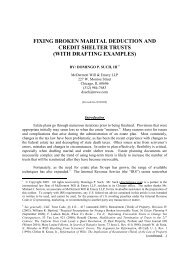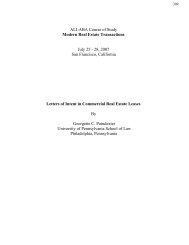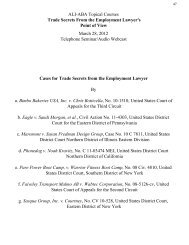Creating and Representing EB-5 Regional Centers - ALI CLE
Creating and Representing EB-5 Regional Centers - ALI CLE
Creating and Representing EB-5 Regional Centers - ALI CLE
- No tags were found...
You also want an ePaper? Increase the reach of your titles
YUMPU automatically turns print PDFs into web optimized ePapers that Google loves.
56<strong>Creating</strong> <strong>and</strong> <strong>Representing</strong> <strong>EB</strong>-5 <strong>Regional</strong> <strong>Centers</strong>• Plans to remain in compliance with ongoing USCIS monitoring requirements;• Proof of the investor’s involvement in the business;• Procedure the regional center will use to perform due diligence on the source of funds of theinvestors; <strong>and</strong>• Documentation of community or political support.At the same time as the regional center requests designation, it can also file an application for preapprovalof its initial project. This procedure is completely optional, <strong>and</strong> investors can file I-526 <strong>EB</strong>-5petitions without project pre-approval. Also, project pre-approval can be filed independently forsubsequent projects. If the regional center opts for project pre-approval, it must file a complete packagecontaining everything that would be required in an investor’s I-526 petition except the investor’s sourceof funds <strong>and</strong> path of funds.The advantages of project pre-approval are the possibility of avoiding multiple adjudications of projects<strong>and</strong> a clear marketing advantage. The disadvantages are that project pre-approval can add significant timeunless it is filed concurrently with the I-924 form. Also, USCIS examiners often disregard the preapproval.Assuming the regional center designation is approved, <strong>and</strong> the marketing effort is successful, thedevelopers want to know when the money will actually be available for the project. Generally, theinvestor must invest 100% of the investment before the I-526 petition is filed. The developer has theoption of either using the money immediately or putting the money into escrow to be released when theinvestor’s I-526 petition is approved. Either option is fully compliant with <strong>EB</strong>-5 rules <strong>and</strong> policies, butthe latter certainly provides a marketing advantage.Because of the substantial processing time to obtain the regional center designation, particular project preapproval(if requested) <strong>and</strong> approval of the investor’s <strong>EB</strong>-5 petition, developers often obtain interim orbridge financing to enable the project to move forward pending receipt of the <strong>EB</strong>-5 capital. The <strong>EB</strong>-5capital then often replaces the bridge financing. This is normal business practice <strong>and</strong> should not create anissue for <strong>EB</strong>-5 petition approval, because it is the new commercial enterprise (<strong>and</strong> not the investor) thatmust create the jobs. However, some USCIS adjudicators have questioned whether the <strong>EB</strong>-5 moneyactually creates the jobs in this scenario.Another sometimes controversial issue involves the requirement that the investment must be “at risk.” 9This principle prevents an investor from being assured of a guaranteed redemption at a specific price.Redemption at fair market value is acceptable. Third party guarantees of the investment have beenallowed. The issue of third party insurance provided by the regional center is an unresolved one.In addition to dealing with investors, regional centers have ongoing reporting requirements. Every year,the investor must file form I-924 A providing, inter alia, the total amount of <strong>EB</strong>-5 capital invested; the9 Matter of Izummi, 22 I&N Dec.169 (Assoc. Comm’r, Examinations 1998).Klasko, Rulon, Stock & Seltzer, LLP Page 7 of 8
















